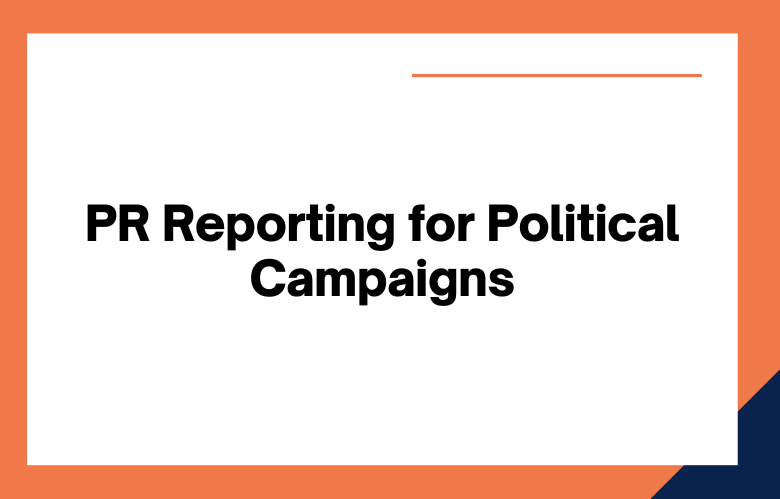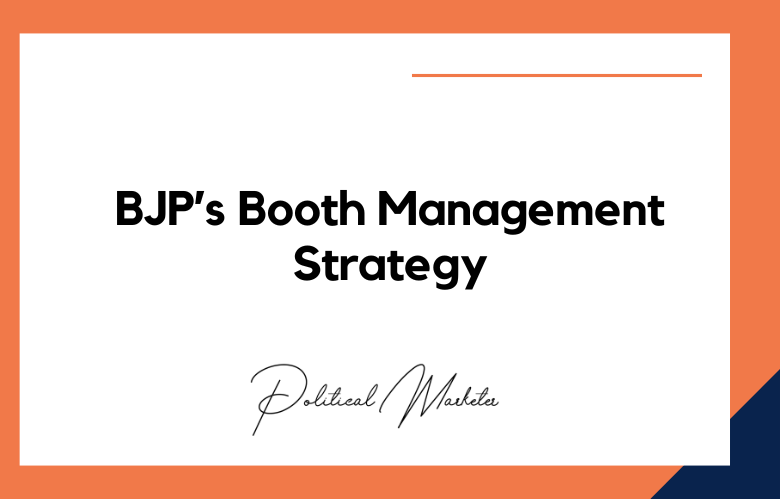In politics, it is essential to have a comprehensive understanding of public relations and its impact on campaigns. Public relations reporting helps political campaigns effectively measure their success, track their progress, and identify areas of improvement. Let’s examine how PR reporting can help your political campaign reach its goals.
Political campaigns are complex and multifaceted operations. A successful campaign requires excellent strategic planning, outreach, and organization. Public relations (PR) reporting is essential to any political campaign. It provides an up-to-date view of how a campaign performs regarding its messaging, media coverage, and other vital metrics. In this blog post, we’ll explore why PR reporting is so essential to a political campaign’s success.
What is PR Reporting?
PR (public relations) reporting involves measuring the effectiveness of a campaign’s public relations efforts to understand the organization’s performance better and make strategic decisions. It includes analyzing media coverage, website traffic, social media engagement, and other data points that can give insight into how well a campaign is doing. These are all important metrics that can help inform decisions about where to allocate resources in the future.
PR reporting involves tracking the success of a publicity campaign by collecting data on its reach, performance, and effectiveness. It includes everything from media coverage to website visitors and social media engagement.
By using reports to measure these metrics, campaigns can gain insight into which strategies are working and which need improvement. It lets them decide where to focus their resources to achieve the best results.
Why is PR Reporting Important?
Implementing PR reporting for political campaigns is critical to success because it helps campaigns keep track of their progress over time and adjust their strategy accordingly. It’s also beneficial because it gives campaigns detailed information about what kind of press coverage they are receiving, how people are engaging with them online, and even how many visitors are coming to their website—all critical factors in determining the success of a campaign. Access to this data helps campaigns analyze their performance compared with other candidates to stay competitive during an election cycle.
How PR Reporting Works
PR reporting involves tracking and analyzing the press coverage you receive and the type of coverage you receive from various outlets. It includes monitoring traditional media coverage (newspapers, magazines, radio stations, etc.) and online coverage (blogs, social media sites, and websites). By understanding how much press coverage you’re getting and what kind of press it is — positive or negative — you can better strategize how to move forward with your campaign messaging and outreach efforts.
Analyzing Your Reach
Another critical component of PR reporting is analyzing the reach of your press release. How far did it travel? Did it reach new audiences? Did it drive traffic to your website or social media accounts? These are all questions that should be answered by effective PR reporting. By looking at which outlets picked up on your story and who shared it with their networks, you can gain valuable insight into who your message is resonating with and begin to focus on those demographics more closely when crafting future messages or outreach plans.
Adapting Your Strategy
The ultimate goal of PR reporting is to ensure that the right people are hearing your message correctly. By tracking and analyzing data related to the reach of your press releases, you can identify areas where improvement may be needed to increase visibility and maximize impact. Suppose something needs to resonate with potential voters or constituents. In that case, it needs to be adjusted or removed from future messaging strategies for a successful outcome for any campaign strategy.
How Do You Create Reports?
Creating reports involves setting specific goals you want your campaign or candidate to achieve—such as increasing media mentions or website traffic—and tracking your progress over time. It’s essential to include all relevant metrics, such as media impressions, website visits, social media engagement numbers, etc., to get a comprehensive picture of your campaign’s performance at any given moment.
Using reporting tools such as Google Analytics can help you quickly generate detailed reports on your progress toward achieving each goal outlined in your strategy.
How to Use PR Reporting to Help My Political Campaign?
PR reporting can be an invaluable tool for any political campaign. The data gathered from these reports can provide insight into how people react to your message or policies, allowing you to adjust your approach accordingly. Tracking critical metrics like website visits or media mentions can give you an idea of how effective your outreach efforts have been. This information can then be used to assess what worked and what didn’t so that you can focus on strategies that produce the desired results.
What Are The Benefits Of Using PR Reports For Political Campaigns?
The benefits of using PR reports for political campaigns include increased visibility, brand recognition, and improved efficiency in outreach efforts. By tracking key metrics, you will gain valuable insight into which strategies are working and which aren’t—allowing you to pivot if necessary and make changes as needed quickly.
By following trends in media coverage or public opinion, you can avoid any potential issues before they become significant problems.
The Benefits of PR Reporting for Political Campaigns
One of the most significant benefits of PR reporting for political campaigns is that it can help candidates stay on track with their messaging. By providing an overview of where a candidate stands in terms of public opinion and media coverage, PR reporting can help guide a campaign’s message strategy. Access to up-to-date data on how people respond to various messages can be invaluable in refining or adjusting existing systems.
Another benefit of PR reporting for political campaigns is that it can provide insights into the effectiveness (or lack thereof) of various tactics used by the campaign. This could include tracking press releases and other forms of communication sent out by the candidate’s team and monitoring social media conversations about the candidate and their policies or platforms. Access to this data helps inform decisions about allocating resources during a given election cycle.
Finally, PR reports provide invaluable information regarding how much positive or negative sentiment exists around a candidate or issue at any given moment. This insight can be critical when planning attack ads or other opposition research against an opponent. It allows strategists to anticipate what kind of response from such efforts before they launch publicly. It also helps guide decisions about which issues should be highlighted most prominently to maximize impact with voters before election day.
PR Reporting for Political Campaigns Consulting
PR Reporting for Political Campaigns Consulting is invaluable for any political campaign.
With the help of professional PR reporting, a political campaign team can identify trends and patterns in their media coverage and use this information to craft more effective messaging and ultimately improve the campaign’s success.
PR Reporting provides essential metrics related to press releases, including total coverage, average tone, and critical messages the candidate or organization communicates in the news media.
This data then informs campaign strategies such as issue selection, message direction, and target audience.
By monitoring news coverage regularly, campaigns can ensure their messages reach the right audiences. It also helps them identify potential gaps in their current strategy so they can adjust accordingly.
PR Reporting allows teams to track how well different segments of society have received their communications.
Through this analysis, they can see if specific messages resonated with certain groups more than others, allowing them to tailor future messages appropriately.
When a message doesn’t resonate well with its audience, teams can quickly respond and make changes as needed before any significant damage is done.
PR Reporting for Political Campaigns Consulting also helps campaigns measure the impact of their efforts on public opinion polls.
By analyzing news coverage and comparing it against public sentiment surveys or other relevant indicators such as fundraising numbers or favorability ratings amongst target demographics, campaigns can better determine the effectiveness of their communication strategies over time.
This type of reporting allows political campaigns to track progress toward achieving communication goals while simultaneously allowing them to pinpoint areas that need improvement or reinvention so they can move closer to victory on election day.
Political campaign consulting has become an increasingly important part of PR reporting for political campaigns.
As the need for data and information to support campaign decisions grows, consulting firms specializing in political campaigns are taking on a more significant role in helping campaigns understand their audiences and craft messaging that resonates.
Consulting firms can help campaigns determine which strategies will most effectively achieve their goals, from Social Media Strategies to Target Audience Engagement Strategies.
They can also provide insight into how best to reach voters and supporters and track trends that could influence an election’s outcome. With the help of PR reporting, consulting firms can accurately measure a campaign’s success or failure and use this data to make informed changes to their communication plans.
These firms can ensure a campaign stays up-to-date with current trends in messaging and technology, helping them stay one step ahead of their opponents. By leveraging the power of PR reporting for political campaign consulting, organizations can ensure they can run successful and efficient campaigns that maximize results and support their goals.
Conclusion
Utilizing PR reports is essential to any successful political campaign because it allows you to track progress over time to know exactly where you stand with voters and stakeholders.
With this information, you can make informed decisions about where to allocate resources to maximize your chances of success on election day.
By taking advantage of this powerful tool, you can ensure that your political campaign runs smoothly from start to finish!
If you are running a political campaign, tracking your progress with PR reporting is essential.
You need to know what is working and what is not so that you can adjust your strategy accordingly.
Our team of experts can help you set up a system for tracking your progress and give you insights into what is working well and where you need to make changes.
Contact us today to learn more about our services and how we can help you run a successful campaign.
Call: +91 9848321284
Email: [email protected]
How to use PR Reporting for Political Campaigns: FAQs
What Is PR Reporting In A Political Campaign?
PR reporting involves tracking, analyzing, and interpreting how campaign activities and messages are covered in the media, both earned (news coverage) and owned channels.
Why Is PR Reporting Important For Political Campaigns?
It provides insight into public perception, media tone, message reach, and earned visibility, enabling strategic adjustments.
What Are The Key Metrics To Track In PR Reporting?
Common metrics include media impressions, sentiment (positive, negative, neutral), share of voice, message accuracy, reach, and media tier quality.
How Do You Measure Share Of Voice In PR?
Calculate the proportion of total political coverage that your campaign receives compared to opponents.
What Tools Can Be Used For Political PR Reporting?
Media monitoring tools like Meltwater, Cision, Google Alerts, and social listening platforms like Brandwatch or Talkwalker can help quantify and qualify coverage.
How Frequently Should PR Reporting Be Done During A Campaign?
Conduct PR reporting weekly or monthly, with more frequent updates around major announcements, debates, or crises.
What Is Sentiment Analysis In PR Reporting?
It assesses whether media and public discourse about the campaign are positive, negative, or neutral, often via either manual coding or automated tools.
What Qualitative Indicators Should PR Reporting Include?
Look for tone of the coverage, message accuracy, editorial endorsements, misquotes or reputational risks, and recurring narratives or themes.
What Are Media Tiers And Why Do They Matter?
Media outlets are categorized by influence (e.g., Tier 1: national TV or newspapers, Tier 2: regional, Tier 3: niche blogs). High-tier coverage is more influential.
What Is Message Pull-Through In PR Reporting?
It measures how frequently your campaign’s key messaging or talking points are repeated in media coverage.
How Do You Track Crisis Coverage In PR Reporting?
Monitor spikes in coverage volume, shifts in sentiment, and message framing following negative events or controversies.
What Role Does Social Media Play In PR Reporting?
Social mentions, engagement, and influencer commentary add context and amplify earned media. Tracking these is essential.
How Do You Benchmark PR Performance?
Compare current metrics like volume, sentiment, and key message penetration to past campaign performance or to your opponents.
Can PR Reporting Inform Campaign Messaging Strategy?
Yes. Identifying which issues, language, or messengers are resonating helps refine media strategy.
How Should PR Reports Be Presented To Campaign Stakeholders?
Use dashboards or slide decks summarizing coverage volume, sentiment trends, key wins or losses, and recommended next moves.
What Formats Are PR Reports Typically Delivered In?
Typical formats include Excel sheets, Google Sheets, PowerPoint decks, or visual dashboards with charts and timelines.
How Do You Attribute Value To Earned Media Coverage?
Use AVE (Advertising Value Equivalency) as a proxy, or triangulate with engagement data and volume to estimate impact.
How Can PR Reporting Detect Media Bias?
By comparing tone and message framing across outlets or regions and spotting consistent themes or disparities.
What Are Common Challenges In Political PR Reporting?
Challenges include differentiating owned versus earned media, tracking real-time coverage, handling misinformation, and interpreting sentiment accurately.
How Can PR Reporting Improve Campaign Responsiveness?
It enables rapid course corrections by amplifying favorable narratives, responding to negative coverage, and preparing spokespeople on trending issues.











